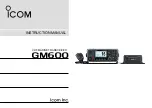
FT-920 Operating Manual
64
for the QMB channels, may be appended with a
seven-digit Alpha-Numeric Label which may aid in
memory channel recognition. Such Labels can be
particularly useful for identifying Shortwave Broad-
cast stations stored in memory, especially because
identification can be difficult if they are broadcasting
in a foreign language you do not understand. Alpha-
Numeric Label programming is simple to accomplish
using the front panel knobs and/or the keys.
Q
First recall the memory channel to which the La-
bel is to be appended.
R
Press the [D
ISPLAY
] key (located immediately to
the right of the VFO-A [TX] LED/Switch); any pre-
viously-stored Label will be displayed in place of
the VFO-B frequency display.
S
Now press the [E
NT
] key on the keypad. The first
“dash” in the VFO-B display area will now blink,
signaling you that Alpha-Numeric entry may be-
gin.
T
Rotate the VFO-B Tuning Dial to select the letter
or number you wish to enter into the first Label
slot. You may also use the [B
AND
] keys by press-
ing repeatedly on a particular key until one of the
letters or the number stamped on the key appears
(for example, repeatedly pressing the [7 MHz] key
toggles between D
Þ
E
Þ
F
Þ
3). Rotating the
VFO-B Tuning Dial is usually faster, however.
U
After you have chosen the first letter/digit for the
Label, press the [U
P
F
] key. A blinking “dash” will
appear to the right of the first digit. Choose the
next letter/digit as in the previous step. Press the
[U
P
F
] key to advance the entry position as you fill
up the Label register, up to a maximum of seven
characters.
V
When entry is complete, press the [E
NT
] key. You
will hear a double beep, which confirms that the
Label storage process was successful.
W
If you make a mistake during entry, you may use
the [D
OWN
G
] key to step backward through the
Label field. If you wish to leave a blank space,
just press the [U
P
F
] key without choosing a let-
ter. To create a space where a letter/digit exists
from a previous entry, the character one incre-
ment counterclockwise from the “A” on the VFO-
B Tuning Dial will inject a space; you may also
use the third selection on the [50 MHz] key (“_”), if
you prefer keyboard entry.
X
Press the [D
ISPLAY
] key to revert to display of the
operating frequency, instead of the Alpha-Numeric
Label. Press [D
ISPLAY
] once more to return to dis-
play of the Label.
Y
Labels generally are not appended to Split Fre-
quency channels, as they are usually stored for 7
MHz SSB applications where one or both frequen-
cies may change often. If you
must store a Label
on a Split channel, the Label will, of course, ob-
scure the display of the VFO-B frequency (usu-
ally the Tx frequency). However, if you move the
VFO-B Tuning Dial (thus entering the Memory
Tune mode) so as to adjust your Tx frequency,
the display will
instantly revert to indication of the
frequency, and will stay in that condition for about
four seconds after tuning has stopped. Then the
Label will return.
Memory Mode Accessories
Moving Memory Data to VFO-A
Data stored on memory channels can easily be
moved to VFO-A, if you like.
y
p
Summary of Contents for FT-920
Page 7: ...FT 920 Operating Manual 5...
Page 9: ...FT 920 Operating Manual 7...
















































